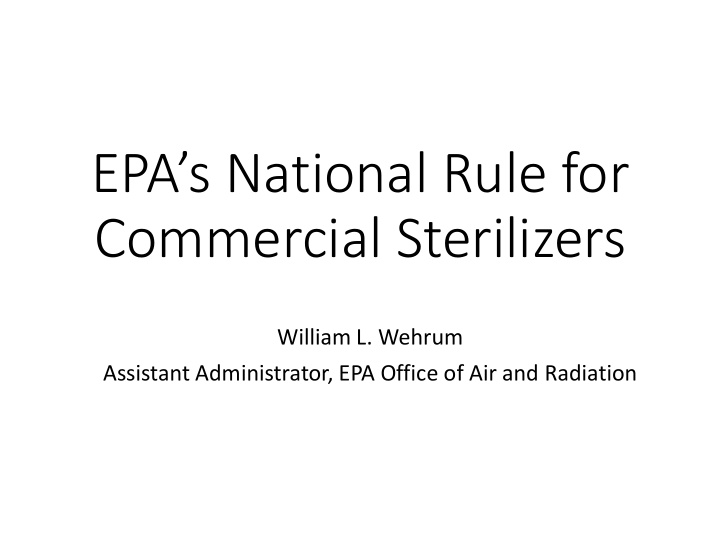



EPA’s National Rule for Commercial Sterilizers William L. Wehrum Assistant Administrator, EPA Office of Air and Radiation
EPA R Response se to 2014 014 NA NATA: A: T Two-pronged s strategy for a addressing e ethylene oxi xide emissions • Prong 1: Review Clean Air Act regulations for facilities that emit ethylene oxide (EtO) to ensure that they protect the public from significant risk. • Two reviews in progress: • Air toxics standards for commercial sterilizers • Air toxics standards for miscellaneous organic chemical manufacturing (the “MON”) • Prong 2: For areas with highest risk, gather additional information on emissions of ethylene oxide. • To support regulatory review • To seek near-term emission reduction opportunities. 2
Commercial S Sterilizer R Rule • Rule history • November 1994 –Rule limits EtO emissions from commercial sterilizers • November 2001 – Rule amended due to safety concerns • April 2006 –EPA completes review, retains 1994 rule (as amended) • August 2018 • NATA identifies census tracts with potentially elevated risk from EtO exposure • EPA begins technology review of current rule under Clean Air Act • More than 100 major and area sources will be affected • Reviewing advancements in control technology • Considering other information, such as risks and costs • Anticipate proposal in summer 2019 3
EP EPA R Regulatory P Proce cess • Step 1: EPA proposes a regulation • Includes specific periods for public input • Written comments • Public hearing • Proposed regulation is published in the Federal Register • Step 2: EPA collects and considers comments from the public to develop a final rule • Written comments and comments at a hearing have the same weight • Step 3: Final regulation is published in the Federal Register, then is added to the Code of Federal Regulations
Preparing t to m make c comments on a proposed rule • Held a public webinar April 24 on “Techniques and Skills for Providing Effective Input in the EPA Rulemaking Process” • Slides and recording are available on the Web to help you prepare • Slides: https://www.epa.gov/il/webinar-information- sterigenics-willowbrook-facility • Recording: https://www.youtube.com/watch?v=jvWjA_3oUmw&feature=y outu.be
Recommend
More recommend